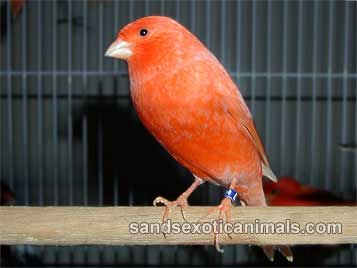
Origin:
Found in the Canary Islands in the Atlantic Ocean off the western coast of Africa.Description:
Canaries are divided into three groups: song, color-bred and type. Song canaries are the rollers, waterslagers and the American singers. Color-bred canaries have evolved over time from the original green and yellow canary. There are now red, white, orange and silver colors as well as many other color variations. Types of canaries include the crested and frilled. The average life span of a canary is 10 to 14 years.Feeding:
Canaries should be fed a good canary seed mixture and/or pellets on a daily basis. Fruits, vegetables and greens will provide variety in their diets and should also be provided on a daily basis. Fruits may include apples, bananas, grapes and watermelon. Vegetables my include broccoli, cucumbers, grated carrots and zucchini. Greens may include spinach, endive and parsley. Keep in mind that tastes vary among birds. Vitamin supplements can also be added to their drinking water. Cuttlebone or mineral stones should be given to add minerals to their diets. Spray millet is an excellent daily addition to their diet. Hard-boiled egg yolk mixed with low-fat cottage cheese is a good treat that provides protein. Grit should always be provided in a separate dish.Housing:
The best cage for a canary is made of metal wire and should be a minimum of 12 inches wide by 24 inches long. Length is more important than height because canaries exercise by flying back and forth. The cage should be placed in an area that is free from drafts. Branches of various thicknesses should be provided to keep the canary's feet and toes fit. Water containers should be cleaned daily to avoid any build up of bacteria. A bath, early in the day, should be provided on a daily basis. Never give your bird a bath too close to nighttime because the bird could become chilled. An open nest may be provided for breeding.Molting:
Molting is the process by which all birds lose each feather on their body and re-grow new ones. Canaries usually molt once or twice a year. Male canaries will quit singing during the molting period. To endure a quick and successful molt, canaries should always be in cool and constant temperatures with a high amount of moisture in the air.Handling:
Canaries are nervous and flighty birds and have a natural fear of movement. Allow the canary at least two weeks to adapt to its new environment. You may then offer treats but if the canary gets nervous, you should withdraw your hand. Talk to the bird so that it gets used to your tone of voice. Continue to offer treats until it perches on your hand. Never grab your canary.
Compliments of:
S & S Exotic Animals, Inc., 1711 Connorvale, Houston, TX 77039 (281) 590-0426
http://www.sandsexoticanimals.com
